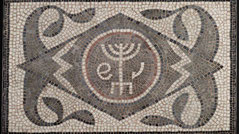ANCIENT AND NEW MENORAHS - 6th-10th Century
This website shows historic Menorahs from the sixth to the tenth century. Menorah illustrations from other centuries: Ancient Menorahs until the 1st century, 2nd century, 3rd century, 4th century, 5th century, 11th-13th century, 14th century, 15th century, 16th century, 17th century, 18th century, 19th century, 20th century, 21st century and coins.
Menorahs 6th Century AD / CE

6th century. Like a historic seal of approval to Jews' claims to their Land, a ceramic stamp with Menorah is found in Akko. The stamp was used to identify baked products (kosher bread) in the Byzantine period. There were no Muslims in the region at the time - because the Quran had not yet been written. Source: Link

6th-10th century. Jewish, lead menorah bulla seal, 7 branched menorah on each side. A bulla is a lump of clay or lead molded around a cord and stamped with a seal that identifies the sender. With a bulla in place a container cannot be violated without visible damage to either the bulla or the cord, thereby ensuring the contents remain tamper-proof until they reach their destination. Weight 11.1g, maximum diameter 16.9mm, 8.9 mm. Forumancientcoins.com, JD34522. Source: Link

6th-7th century. Brass handle-ornament, broken from a lamp from Alexandria (Africa, Egypt): crescent with knobbed tips, enclosing a Menorah. The crescent rises from a floral support, with part of a ring-handle below. One branch of the candlestick is lost. Surface coloration: green. Dimensions: Height: 10.45 cm, Width: 9.15 cm. Analysis: copper: 79.1; lead: 1.76; tin: 7.18; zinc: 7.52. The British Museum, number: EA38395. Source: Link

6th-7th century. A silver ring from the Byzantine period comprising a round-section hoop with a circular tablet-bezel. The main motif of the ring is Jewish, ie. the Menorah surrounded by the symbols Shofar (a ram-horn) and Etrog, symbols related to the Sukkot feast. It was probably used as a signet ring, exemplifying in its style the taste of the prosperous Jewish community of the sixth-seventh centuries. LiveAuctioneers, Lot 0232 , 2020. Source: Link

6th century. Ancient Byzantine Empire Bronze ring with Menorah, Judaica, ancient Israel. Size: 20 mm. Provenance: EX Frishman Gallery Tel Aviv Israel, Ex NYC Collection. LiveAuctioneers 2018, Lot 0133. Source: Link

6th-7th century. IAA archaeologist Dr. Einat Ambar-Armon said, “Unlike the modern day symbol of the state in which the Temple’s menorah is depicted with 7 branches and a single broad base, the menorah engraved on the ancient lamp has 8 branches and a 3-legged base. The discovery of a lamp decorated with a menorah, a symbol of the Jewish people, is without doubt exciting, especially at a site with such a unique heritage in part of the Sanhedrin Trail.” Photo: Y. Berman/G. Amit, Israel Antiquities Authority). Link1, Link2
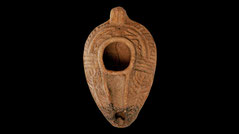
6th-7th century. Menorah Late Samaritan Oil Lamp. Dimensions: 10.0cm length, 6.2cm width, 3.8cm height. Good condition, Fully INTACT with some erosion to surface areas. Decorated with two Menorahs, one on each side. Source: Link

6th century. Ancient Samaritan menorah oil lamp, Holy Land Israel. Source: Link

6th-7th century. A large Byzantine Christian terracotta oil lamp. Mold-made with a large fill-hole and an integral nozzle with two wick holes present on a ring base. The nozzle is decorated with a stylized palm tree with two stylized “flights of stairs” on either side. A large handle is present and is decorated with four circles around a central raised dot. This may be a stylized cross or a reference to the five wounds of Christ. Found in Bethlehem. Source: Link

6th-10th century AD. Byzantine Ceramic Judaica Oil Lamp with Menorah. A creamware terracotta oil lamp with extended nozzle, stub handle to the rear with Jewish menorah motif, rosette to the underside. 56 grams, 10.5 cm (4"). Liveauctioneers 2013, Lot 723. Source: Link

6th century. A Byzantine Oil Lamp with 6 Nozzles decorate with a degenerated menorah, 2 crosses in arches and 2 palm branches. Dimensions: Length: 11.3cm. Source: Link

6th-7th century. Jewish Brown Glass Hexagonal Jar with menorah. Height: 8.7cm. Source: Link

6th-7th century. An early Jewish glass jar. Amber brown in color, mold-blown, with a flat shoulder and short neck, hexagonal body adorned with sunken motifs, one panel with a menorah on a tripod flanked by a shofar (ram's horn), lulav (palm branch) and etrog (citron), interspersed with three panels, each with a palm tree on a triangular trunk. Size: 3 1/8 in. (7.9 cm.) high. Christie's, Sale 1915, Lot 98. Source: Link

6th-7th century (578-629 AD?). An early Jewish hexagonal glass Jar, Byzantine Period, Jerusalem. Dark brown in color, the mouth and neck free-blown, the body mold-blown with six panels decorated in sunk relief, each panel with a border of recessed dots, in the panels from left to right: a flaming menorah on a tripod stand; an X-shaped element with a leaf at the end of each arm, the cross-bar with a loop at each end... Size: 2 7/8 in. (7.3 cm) high. Christie's, Sale 1163, Lot 337. Source: Link1, Link2

6th-7th century. Flask with Jewish and Christian symbols. Glass. Height: 8.9 cm. Small hexagonal flask with a flat base. Each of the six sides of the flask is decorated with a symbol: an ornament in the form of a cross adorned with heart-shaped patterns at the end of each arm, a stylized palm tree, a shrine represented by two columns with stylized capitals supporting an arch, twice the motif of concentric lozenges and, finally, a menorah on a tripod base with its seven lamps lit. Phoenix Ancient Art: Link

6th-7th century. A Byzantine Dark Amber Glass Jar, Jerusalem. The menorah usually accompanied by other ritual objects stands for the Temple Menorah, holy rituals (the incense shovel) and the Jewish festivals (shofar and lulav). Sothebys. Source: Link

6th-7th century, Byzantine. Glass Jar with menorah. Color: Brown. Dimensions: Diameter 6.7 cm, Height 10 cm, Diameter 6 cm. Technique: Free Modeled, Mould Blown. Museum: Muza Eretz Israel Museum Tel-Aviv. Source: Link

500-1000. Judea. Byzantine Period. Glass pendant (20 mm, 2.21 gm). Made of yellow glass and a faint purple tint featuring a six-branched menorah, with a very thin metallic coating. From The Dr. Patrick Tan Collection. Source: Link

550. Christian Topography by Cosmas Indicopleustes ('India-voyager') of Alexandria. He was a Greek sailor in the early 6th century who travelled to Ethiopia, India and Sri Lanka. He then became a monk, probably of Nestorian tendencies, and around 550 AD wrote a strange book, copiously illustrated; see copies of his work: Link1, Link2 and 1707-1864, Copy 9th century (below), Copy 1010, Wikipedia. The 7 lamps are represented as 7 doves (Christian symbol of the Holy Spirit).

6th century. Interior of Susiyah synagogue with 6th century date tree motif, Hebron, West Bank (photo). The menorah has circular arms. Credit: Interior of Susiyah synagogue with 6th century date tree motif, Hebron, West Bank (photo) / Photo © Zev Radovan / Bridgeman Images. IMAGE number BLP1220471. Source: Link

6th-7th century. A menorah carving found in a 1,400-year-old Byzantine church in Jordan provides the first substantial evidence of Jewish presence in the ancient city of Abila, which has long thought to have a Jewish population, Haaretz reported. The seven-branched menorah with a three-legged branch was carved on a stone block found in the second tier of a wall in the Jordanian church. BrakingIsraelNews. Link

6th-7th century. This mosaic was unearthed in a synagogue in northern Beit She'an (Beth Shean). The center features a shrine with two columns. This was probably both a symbolic representation of the Temple as well as an actual depiction of the main synagogue wall, in which the Torah shrine is shown covered by a curtain (parokhet) and flanked by large menorahs with glass oil lamps. © The Israel Museum, Jerusalem. Source: Link1, Link2, Link3, Link4, Link5

6th-7th century. Mosaic from the house of Leontis in Beth Shean (Beit She'an). Menorah and birds. Reading: "Be remembered for good Kirios Leontis Klubas for making this mosaic with his [money] for the redemption [of his soul and the soul] of his brother Jonathan." Museum of Israel, Jerusalem. Source: Link1, Link2

6th century. Beth Alpha (Beit Alfa), Israel. Detail of ancient synagogue mosaic floor. Lions flank a Torah Ark surrounded by symbols of the Jerusalem Temple. On the pediment is an eternal flame with two birds. On either side of the ark are two lit menorahs, and on the side of each of them are traditional ritual objects: Shofar, Lulav, Etrog. Source: Link1, Link2, Link3, Link4, Link5, Link6

6th century (or before 6th AD?). The Maon Synagogue is a 6th-century synagogue and archaeological site located in the Negev Desert near Kibbutz Nirim and Kibbutz Nir Oz. It is noted for its "magnificent" mosaic floor. The lions overlay the two medallions in the eleventh row to the left and right of the menorah. Two pear shaped ethrogs with short stems flank the shaft of the menorah. An identical floor was found in the ancient synagogue in Gaza. Source: Link1, Link2, Link3

6th century. The synagogue in Maon is well know for the magnificent mosaic floor. It displays an amphora, bird, animal, fruit, wine processing, a menorah flanked by two lions, etrogs, a shofar, a lulav and Aramaic inscription. A similar mosaic was found in a nearby church at Shallal. Link1, Link2, Link3, Link4

6th century. Painting from Jewish catacombs in Venosa, Italy, showing key Jewish symbols: a Menorah, flanked by a shofar, lulav, etrog, and wine vase. Source: Link

6th-7th century. A menorah carved on a stone block, found in a 1400-year-old Byzantine church in Abila, Jordan is the first tangible evidence of a Jewish presence in the ancient Hellenistic city. The seven-branched menorah with tripod base, inscribed on a reused stone in the basilica. Link

6th-7th century. Marble Fragment of a synagogue screen with menorah, a lulav (palm branch), an etrog (citron) and a shofar (ram's horn). Ashkelon, southern coast. Photo © The Israel Museum, by Dr. Jean-Luc Pilon, Canadian Museum of Civilization. Collection of the Deutsches Evangelisches Institut für Altertumswissenschaft des Heiligen Landes, Jerusalem, exhibited at The Israel Museum, Jerusalem. Source: Link

6th century. This menorah was found on the floor of the En Gedi synagogue near the Torah shrine. It is the only one of its kind, its branches made of small spheres that imitate the “calyxes and petals” of the Temple menorah. The use of this item in the synagogue service is unclear. Item Type: Beaker. The Israel Museum, Jerusalem. Source: Link

6th–7th century. Seven-branched menorah (reconstruction). Location: Ma'on, Southern Hebron Hills. This tall, elegant menorah decorated with leaves and lions originally had oil lamps at the top of its branches. It is the largest Byzantine-period three-dimensional menorah ever found. Photo © Israel Museum, Jerusalem, by David Harris. Source: Link1, Link2, Link3, Link4

6th–8th century. Bas-relief (reconstruction). Marble slab, found near Kiryat Tivon. The Menorah rests on three thin supports in the form of curved legs, and not on a massive inclined or stepped base. Department of Antiquities of Israel. Source: Link
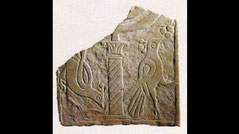
6th century. Tomb stone from Spain that is now in a museum in Comarcal (Spain) shows part of a menorah below which there are two peacocks. The imagery used on this and on the trough closely resembles the imagery used on Christian stones of that period across France, Italy and Spain. Source: Link (see also similar peacock images from Ancient Priene Synagogue from 3rd-4th century: Link)

6th century. Tomb stone from Tortosa (Spain) that has long inscriptions in the three languages. On the right side is a small menorah that confirms that this is a Jewish stone. In: "A Vanished World The Jewish Experience in Spain". Source: Link

6th century. Adriya Synagogue. Architectural fragment Lintel. Byzantine Period. Photograph Copyright: Center for Jewish Art. The stone is decorated with seven-branched menorah,standing on a three -legged base.The curving branches are connected on the top by an horizontal bar. Source: Link
Menorahs - 7th Century AD / CE

7th century. Fascinating ancient gold treasure discovered in Jerusalem (at the City of David and at the Temple Mount's southern wall) by Dr. Eilat Mazar. Please find more information below. Source: Link

7th century. Ancient golden Hanging. This 10-cm gold medallion was discovered in Hebrew University excavations at the foot of the Temple Mount in Jerusalem. Etched into the medallion are a menorah (Temple candelabrum), shofar (left) and Torah scroll (right). Along with other treasures including thirty-six gold coins and gold and silver jewelry, the medallion was likely abandoned during the Persian conquest of Jerusalem in 614 CE. Source: Link1, Link2, Link3, Link4

688-713. The Codex Amiatinus is the earliest surviving manuscript of the complete Bible in the Latin Vulgate. It is considered the most accurate copy of Saint Jerome’s original translation and was used in the revision of the Vulgate by Pope Sixtus V in 1585‒90. The codex also includes a two-page plan of the Tabernacle (with seven-armed menorah) in the Temple at Jerusalem. Source: Link1, Link2, Link3

7th-8th century. Clay oil lamp from Sicily (?, Italy), oval; orange clay, buff surface; carinated body and sharply sloping shoulders; sunken top with raised rim extending round wick-hole; unpierced handle; raised rim around filling-hole; discus - two rows of raised points interrupted by four large ring-and-dot patterns; small cross of raised points in nozzle-channel; slightly sunken, undefined base with cross within a circle in relief; Menorah - between cross and handle. The British Museum. Source: Link

7th-9th century. A Jewish terracotta oil lamp decorated with a seven branched menorah rising from a palm branch. Dimenisons: Length: 9.1cm. Source: Link

7th-9th century. A Jewish Terracotta Oil Lamp with 8 nozzles. Decorated with a menorah, two lulavs and Greek inscription “With the Help of God”. Dimensions: Length: 12.6cm. Source: Link

600 AD. Ancient Jordan Byzantine lead bulla with a menorah. Dimensions: 17 mm. 4.90GM. Vcoins. Source: Link

7th century. Samuel. Seal (Lead, 17 mm, 2.77 g, 12 h). Seven-branched menorah with a tripod base. Rev. CAM/OVH/ΛOV in three lines. Unpublished in the standard references. Very fine. This attractive early Byzantine seal shows a rare depiction of a menorah and belonged to a person bearing a Hebrew name. VCoins. Source: Link
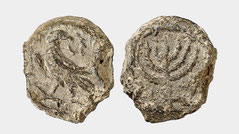
7th century. Jewish lead seal. Iconographic seal with menorah. Eagle with wreath in its beak. Rev .: menorah between shofar, lulav, etrog. Beige patina. 3.54 g. Source: Link
Islamic Menorahs - 7th-8th Century (after 695/696)
What many people do not know: During the beginning of Islam, the seven-armed menorah was also used by the Muslims. But since this was first a Jewish symbol and later also a widespread Christian symbol, the seven-armed Menorah was replaced by Muslims in a five-armed candelabrum in order to distance themselves from Jews and Christians. More information from one of the many websites on this topic:
“Archaeologists expose Muslim-Jewish ‘dialogue’ in Jerusalem from 1,300 years ago... Indeed, Jerusalem’s Muslim identity was forged alongside the dawn of Islam. However, according to a pair of Israeli archaeologists, that identity was originally one of coexistence and tolerance.They say they have the 1,300-year-old archaeological evidence to prove it, and now they want to share it with the Muslim world.… As evidence, the researchers offer 1,300-year-old coins and other vessels from the Umayyad period (from 638 CE) which bear the seven-stemmed menorah... Take the coins, for instance. Minted in Jerusalem under Muslim rule, the [seven-branched] menorah appears in the center of one side, accompanied by Shahada Arabic stating ’There is no god but Allah.’ The other side bears the inscription: ’Mohammed (is the) Messenger of God.’ Researched by Dan Barag in the 1980s, these coins are Bronze issues dating to after 696/97, during the Umayyad post-reform era... The seven-branched menorah coin was soon followed by a five-branched menorah issue, according to an essay by a menorah expert, Yeshiva University Prof. Steven Fine... The later use of five-branched menorah, he writes, was then a move away from Jewish and Christian symbolism” (TimesofIsrael.com).
Today, the symbol of the Menorah can serve to move Jews, Christians and Muslims to a path of peace. It was not man, but it was God who formed the Menorah in the time of Moses. It is his symbol, light and love.

8th century. Umayyad coin (after the reform) with a seven-branched menorah model. Made of bronze. These coins were probably minted in Jerusalem. On one side of the coin is a seven-branched menorah with an inscription in Arabic: “There is no God but Allah.” On the other side of the coin is an Arabic inscription, “Muhammad, the messenger of God,” and above it is the symbol of the Muslim crescent. © The Israel Museum, Jerusalem; Vladimir Nikhin). Source: Link

8th century (early). A copper basin fragment with the seven-branched menorah symbol was found next to Kibbutz Beit Zera, together with another fragment that bears an inscription in Arabic. Umayyad period. (A. Peled). TimesofIsrael. Source: Link

7th-8th century. Islamic menorah coin. The obverse of the 14mm diameter coin depicts a five-branch menorah or candelabra or the dome of a mosque if the coin is turned sideways. The legend translates to “There is no god but Allah alone.” The reverse repeats this Kalima or “statement of faith” legend within a circle. The repeat of the legend is unusual for Islamic coins. Usually coins include the prophetic mission statement alluding to Muhammad being the apostle of Allah. Source: Link
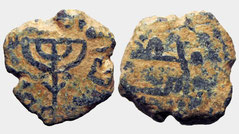
695-750 AD. Jerusalem mint. "Mohammad is the Prophet of Allah." An unusual figural bronze struck in Jerusalem by the new Islamic rulers, with a clearly Jewish motif. The Jewish inhabitants of the new Arab province of Bilad as Sham (Palestine) got along tolerably well with their new Islamic rulers, having a common enemy in the implacably hostile Christian Byzantine empire. And the early Ummayad calpihs were obviously willing to allow the expression of Jewish religious symbolism. Link

695-750 AD. Group of 3 Islamic coins. Islamic dynasties. Ummayads. Æ Fals (14.5mm). Jerusalem mint. Candlestick on tripod base Menorah. "Mohammad is the Prophet of Allah." SIC Ashmolean; Barag type 4; Walker, Arab-Byzantine 605. Source: Link

696-750 A.D. Struck by Abd al Melek at the Jerusalem mint. Bronze fals of 16 mm. Obverse: Five-branched menorah (candelabra). Reverse: 'Mohammad is the Prophet of Allah'. (2nd. half of the kalima). SNA Tubingen 29. Bone-7.3. W-605. The late Prof. Dan Barag used to explain the presence of a Jewish symbol on an Islamic coin by the control of the mint by Jewish officials / mint-masters. Source: Link

698-751 AD. Bronze Coins. Umayyad Dynasty. Minted in Jerusalem by the new Islamic rulers, with a clearly Jewish motif. The type was early-on identified as a menorah, although as Barag points out, only one rare variety has a true representation of the menorah with 7 arms and a flat base. The Jewish inhabitants of the new Arab province of Bilad as Sham (Palestine) got along tolerably well with their new Islamic rulers, having a common enemy in the implacably hostile Christian Byzantine Empire. As well, the early Umayyad caliphs were obviously willing to allow the expression of Jewish religious symbolism. Link1, Link2

696-750 AD. The Islamic Candlestick Coins of Jerusalem. Inscription: “There is no god but Allah alone” around / “Muhammad is Allah’s messenger” in three lines; crescent below. Please see: D. Barag, “The Islamic Candlestick Coins of Jerusalem, INJ 10, type 4; Walker 605; Album 163. Near VF, dark green patina, earthen deposits. This series begins with a seven-branched candelabra, as the menorah, but appears to have been fairly quickly reduced to five branches." Source: Link1, Link2, Link3, Link4

697-750 AD. Islamic, Umayyad Caliphate. Uncertain period (post-reform), AH 77-132. Fals (Bronze, 13 mm, 2.81 g, 11 h), Menorah type, Iliya (Jerusalem). Candlestick with five branches; around 'no God but Allah, He is alone' in Kufic. Rev. 'Muhammad is the messenger of Allah' in three lines in Kufic. D. Barag, "The Islamic Candlestick Coins of Jerusalem," INJ 10, type 4. SICA II, 1310 (mint uncertain). Leu Numismatik AG Web Auction 8, date: 29 June 2019, Lot number: 1850. Source: Link1, Link2

697-750 AD. Islamic coin, Æ Fals (15mm, 2.53 g, 9h). A seven-branched candelabra, as the menorah, but appears to have been fairly quickly reduced to five branches. Barag (p. 47, note 40) raises the possibility of this symbolizing the Five Pillars of Islam. In an another possible appropriation of the traditional Jewish symbol, Album (p. 22) notes: “Turned upside-down, this design resembles the dome of a mosque, which may have been the engraver’s intention.” Source: Link

738+ AD. Umayyad Governors, Palestine, AE fals (14mm, 2.79gm, 8h). O: Arabic la ilah illah Allah wahdahu ("There is no god but Allah, [He is] alone"). Menorah (candelabra) with 5 branches. R: Muhammad / rassul / Allah ("Muhammad is the prophet of Allah"). While most examples of the Umayyad menorah coin depict a candlestick with 5 branches, a few very rare examples are known with 7. It seems likely that the reduction to five branches was in deference to Muslim sensibilities. Source: Link

738-739 AD. Islamic coin. Issuer: Umayyad Govenors. Mint: Illiya-Jerusalem. Diameter: 14 mm. Weight: 2.88 g. Obverse: Arabic legend: la ilah illah Allah wahdahu ("There is no god but Allah, [He is] alone"). Obverse Description: menorah (candelabra) with 5 branches. Reverse Legend: Muhammad, rassul, Allah ("Muhammad is the prophet of Allah"). Source: Link

697-750 AD. Umayyad Caliphate. Uncertain period (post-reform). AH 77-132. Æ Fals (16mm, 2.40 g, 6h). Menorah type. Iliya (Jerusalem) mint. D. Barag, "The Islamic Candlestick Coins of Jerusalem," INJ 10, type 4; Walker, Arab-Byzantine 605; Album 163; ICV –. VF, green patina with thick earthen deposits. Rarely seen with complete Menorah. VCoins. Source: Link

8th century. An Islamic Menorah Bronze Coin, Post Reform, after 696 CE. Minted probably for the Jewish population of Jerusalem. AE 14.5-13.5 mm. Obverse: Menorah with 5 branches. Inscription: "There is no god except Allah alone." Reverse: "Muhamad is Allah's messenger." See: Dan Barag: "The Islamic Candlestick Coins of Jerusalem" Israel Numismatic Journal 10 (1991), pp.40-48Pls. Vcoins.com. Source: Link

8th century. In the center of a Jerusalem-minted Muslim coin from the Umayyad period stands a five-branched Menorah. On one side the Arabic inscription ‘There is no God but Allah.’ On the other side of the coin is the Arabic inscription ‘Muhammad, the messenger of God.’ (courtesy Assaf Avraham). TimesofIsrael.com. Source: Link

8th century (likely struck between the 720's and 750 CE). Early Islamic, umayyad period copper menorah candlestick coin. while lacking a mint name, these types are widely believed to have been struck in Jerusalem in what was known as 'jund filastin' (the military district of Palestine). A menorah candlestick with 5 branches surrounded by part of the Islamic declaration of faith on one side, and the second part of it on the other side. All legends are in Arabic. Source: Link

7th-10th century AD. Islamic Glass Vessel with Menorahs. A glass bottle with convex conical-shaped body, cylindrical neck, broad flattened rim and dimple base; circumferential band of menorah-like motifs. 120 grams, 10.7cm (4 1/4"). Property of a London gentleman; formerly with the Mahboubian Gallery, London, UK; acquired before 1972. LiveAuctioneers, Lot 1803, 2021, Source: Link
Menorahs - 8th Century AD / CE

8th-9th century. Čelarevo (Serbia) Menorah fragment. Since 1972, archaeological excavations have revealed about 650 graves on a burial site. The site characteristic by the graves featuring Judaic culture, where fragments of Roman brick were found with patterns of a seven-branched candelabrum (menorah), etrog and lulav carved on a later date. Few inscriptions on the brick fragments were deciphered as Jehuda or Yahweh and Israel. Source: Link

8th-9th century. Medieval artifacts from Chelarevo (Čelarevo, Serbia). Scholars are divided over whether they come from a Khazarian Jewish community, an Avar Jewish community (if any really existed), an Israelite Jewish community, or some combination thereof. Some of the skulls in the burials were racially Mongoloid, whereas the ancient Israelites were Caucasoid. The Jewish graves included Roman brick fragments with engravings of menorahs, etrogs, and lulavs. Source: Link1, Link2, Link3

8th-14th century. The Phoenician Menorah of Ireland can be found on what is known as a pillow stone in Cloontuskert, county Roscommon. It is a Judeo-Christian symbol with the cross in the middle and the seven-armed Menorah above. Four Psi are at the end. Psi (Greek: uppercase Ψ, lowercase ψ) is the 23rd letter of the Greek alphabet and has a numeric value of 700. The Psi is also a pagan symbol for Neptune. Sources: Link1 Link2 Link3 Link4
Menorahs - 9th Century

800 AD. Ancient Holy Land Byzantine lead token with menorah. Dimensions: 19 MM. 5.17GM. Vcoins. Source: Link

870-875. Latin Bible of San Paolo fuori le Mura is a 9th-century illuminated Bible of the OT and NT; the most sumptuous surviving Carolingian Bible. The picture shows the building of the covenant tent and the priestly consecration of Aaron and his sons. The Menorah has no round arms. The candlestick stands in front of the Ark of the Covenant (in contrast to the Bible), which corresponds to the Christian candlestick in front of the altar. Exhibition (2017) at the Vatican and the Jewish Museum of Rome. (Credit: Paul Haring/CNS). Source: Link1, Link2, Link3, Link4

830 A.D. Handwritings with menorah from the former Benedictine monastery of St. Emmeram in Regensburg, Germany. Title: "Bedae de tabernaculo et vasis eius ac vestibus sacerdotum libri III". Bayerische Staatsbibliothek, BSB Clm 14390. Source: Link

9th century. Copy of the original from the 6th century: Around 550 AD, Cosmas Indicopleustes wrote the illustrated Christian Topography. Copyright Biblioteca Apostolica Vaticana, Shelfmark: Vat.gr.699. Source: Link1, Link2, Link3
See also the lamp representation from 1010 AD; the 7 lamps were depicted as doves to symbolize the work of the Holy Spirit: Link

9th-10th century (?). Jewish tombstone (tomba ebraica) from Bari, Italy. Already after the destruction of Jerusalem in the year 70 AD, Jews were abducted from Titus to Bari and dragged in iron chains through the streets. Bari had a Jewish colony until 1541. Several Jewish tombstones and catacombs were found. Bari, located on the coast with an important port, is the second most important economic centre of mainland Southern Italy after Naples. Photo: Chiara Divella. Source: Link1, Link2
Menorahs - 10th Century

929 AD. Paired pages from the so-called "The First Leningrad Pentateuch". Egypt. Parchment, ink, gold leaf. The forms of the menorah on the sheets are different: on the left sheet the stems are rounded, and on the right they are not typical. Russian National Library, St. Petersburg, Russia. Source: Link

929 AD. Same picture as above (Evr. II В 17, fol. IV.). Second Firkovich Collection. Among the most noteworthy items is, first of all, the Leningrad Pentateuch of 929, the oldest illuminated dated Hebrew manuscript. In the center is the seven-branched candelabrum menorah, under it are the ark and two tablets with leaves-wings on the sides (wings are symbols of cherubim), the altar of incense is placed to the right, little lower is a jar of manna, etc. Source: Link

10th century. The Vision of Zacharias. In: Biblia Sancti Petri Rodensis (Remigius Autissiodorensis). The candlestick does not correspond to the Menorah, but to a rake of light. Bibliothèque nationale de France. Département des manuscrits. Latin 6 (3). Source: Link1, Link2, Link3, Link4
A similar presentation as in the Rich Bernward Gospels from 1015: Link

10th-12th century. Medieval Gold Ring with Enamelled Minora - Menorah. Size: USA= 8 1/2 - GB= R - 1.9 cm inside D. Material: Gold, 13.6 grms. Provenance: British private collection, acquired in the 1990s on the London art market. Catawiki. Source: Link

10th-14th century. A Byzantine silver ring depicting 7 branches menorah, the round bezel with menorah and base incised and inlaid with blue paste, three green inlaid divots around. Size: 20 x 19 x 16 mm. (W: 6.2g). Ring size about 8 1/2. A nice example with attractive tone. Ex Los Angeles private collection. LiveAuctioneers, Lot 0228, 2019, Source: Link
There are also similar menorah rings from the 5th century: Link
Menorah Images from other Centuries:
Note: It's nice to see the menorah pictures. However, according to the Bible Jesus (Hebrew Yeshua) is the true spiritual
meaning behind the physical Menorah. He is the true and eternal spiritual light: "I am the light of the world. Whoever follows me will never walk in darkness, but will
have the light of life" (John 8:12). The menorah also symbolizes the Tree of Life, because Jesus is the way to life: "I am the way, and the truth, and the life. No one comes to the
Father except through me" (John 14:6). Jesus' Word and the Bible are the light in this world. "Your word is a lamp to my feet and a light to my path" (Ps 119:105 and
John 1:1-17).
Copyright info and disclaimer: All content and all photos from ancient and new menorahs provided on this website is for informational purposes only. It is not allowed to publish photos from this website on other websites or printed literature. Please always use only the original sources of the photos. We make no representations as to the accuracy or completeness of any information on this website or found by following any link on this website. We will not be liable for any errors or omissions in this information. We will not be liable for any losses, injuries, or damages from the display or use of this information. We can not guarantee the validity and accuracy of the information, please always check the original source. The opinions expressed from other website owners and those providing comments are theirs alone, and do not reflect the opinions of us.
